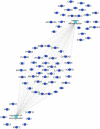Dosing and formulation of antenatal corticosteroids for fetal lung maturation and gene expression in rhesus macaques
- PMID: 31227752
- PMCID: PMC6588577
- DOI: 10.1038/s41598-019-45171-6
Dosing and formulation of antenatal corticosteroids for fetal lung maturation and gene expression in rhesus macaques
Abstract
Antenatal corticosteroids (ANS) are the major intervention to decrease respiratory distress syndrome and mortality from premature birth and are standard of care. The use of ANS is expanding to include new indications and gestational ages, although the recommended dosing was never optimized. The most widely used treatment is two intramuscular doses of a 1:1 mixture of betamethasone-phosphate (Beta-P) and betamethasone-acetate (Beta-Ac) - the clinical drug. We tested in a primate model the efficacy of the slow release Beta-Ac alone for enhancing fetal lung maturation and to reduce fetal corticosteroid exposure and potential toxic effects. Pregnant rhesus macaques at 127 days of gestation (80% of term) were treated with either the clinical drug (0.25 mg/kg) or Beta-Ac (0.125 mg/kg). Beta-Ac alone increased lung compliance and surfactant concentration in the fetal lung equivalently to the clinical drug. By transcriptome analyses the early suppression of genes associated with immune responses and developmental pathways were less affected by Beta-Ac than the clinical drug. Promoter and regulatory analysis prediction identified differentially expressed genes targeted by the glucocorticoid receptor in the lung. At 5 days the clinical drug suppressed genes associated with neuronal development and differentiation in the fetal hippocampus compared to control, while low dose Beta-Ac alone did not. A low dose ANS treatment with Beta-Ac should be assessed for efficacy in human trials.
Conflict of interest statement
The authors declare no competing interests.
Figures







References
-
- In WHO Recommendations on Interventions to Improve Preterm Birth Outcomes WHO Guidelines Approved by the Guidelines Review Committee (2015). - PubMed
Publication types
MeSH terms
Substances
Grants and funding
LinkOut - more resources
Full Text Sources
Medical
Molecular Biology Databases

